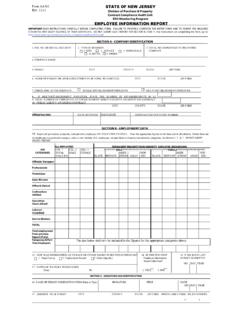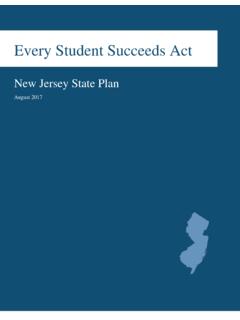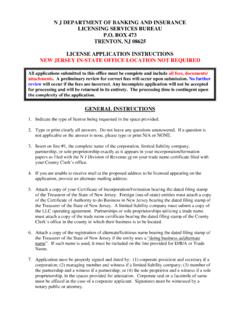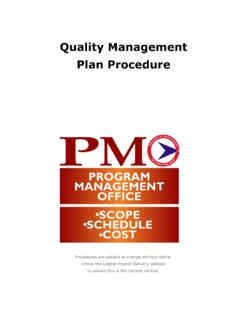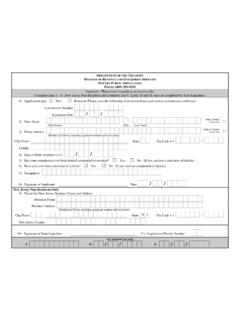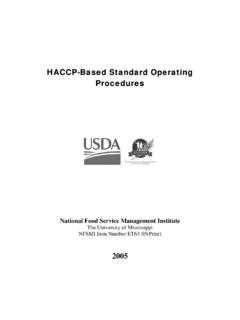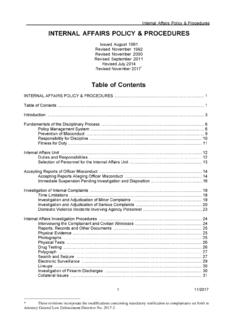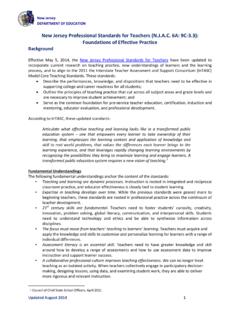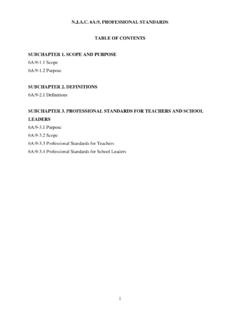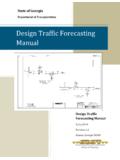Transcription of Cost Estimating Guideline - State
1 Cost Estimating Guideline February, 2017 Procedures are subject to change without notice. Check the Capital Project Delivery website to ensure this is the current version. Table of Contents Section 1 - Introduction .. 1 Purpose .. 1 General Estimating Concepts .. 1 Contents of the Cost Estimating Guideline .. 2 Section 2 - Cost Management Process .. 3 Estimating Concepts Throughout Project Development Stages .. 3 NJDOT Cost Estimation Process by CPD Delivery Phase .. 4 NJDOT Cost Estimating Process Summary .. 9 Estimating Process Background .. 10 Estimate Documentation .. 11 Project Estimate File.
2 12 Major Project Program Cost Estimating (>$500M) .. 13 Section 3 - Cost Estimating Methods .. 14 Introduction .. 14 AASHTOWare Project Cost Estimation software .. 14 AASHTOWare Project Software (formerly Trns*port) .. 14 Historical Bid-Based Estimating .. 14 Analogous or Similar Project Estimating .. 14 Historical Percentages Estimating .. 15 Cost-Based Estimating (scratch Estimating ) .. 15 Section 4 - Cost Estimating Factors .. 17 Introduction .. 17 Cost Drivers .. 17 Lump Sum Items .. 19 Section 5 - Estimate 21 Introduction .. 21 Estimate Review .. 21 Estimate Review Process .. 22 Section 6 - Bid Analysis.
3 24 Overview .. 24 Bid Review Process .. 25 Competition Adequacy .. 29 Market Review .. 30 Constructability Review .. 31 Distribution and Range of Bids .. 31 High/Low Item Review for Quantity Verification .. 32 Mathematically Unbalanced Bids .. 35 Materially Unbalanced Bids .. 36 Lump-Sum Price Comparison .. 37 Review Team Recommendation .. 37 FHWA & NJDOT Requirements .. 38 Components of a Written Bid Analysis .. 39 Components of an Analysis Table .. 40 Components of an Award/Rejection Memo .. 40 Bid Analysis Quick Start Guide .. 41 Sample - Bid Opening Memo: .. 42 Sample - Bid Analysis #1 Comprehensive Case.
4 43 Sample Bid Analysis #2 .. 50 Sample - Analysis Table (Attachment A) .. 56 Sample - Award Memo .. 57 Attachment 1 (Concept Development Cost Estimating Calculation Spreadsheets) .. A-1 1 Section 1 - Introduction Purpose The purpose of this Guideline is to provide guidance to NJDOT employees and others in the methodology and for developing, documenting and reviewing construction cost estimates throughout the project development process. In order to successfully address transportation needs, the NJDOT must have reliable construction cost estimates and associated construction cost estimate documentation that supports the development of the construction cost estimate from project programming and planning through project Plans, Specifications and Estimate (PS&E).
5 This guidance is to be used by all NJDOT service areas, Capital Investment Planning and Grant Administration, Capital Program Management, Operations, transportation System Management. General Estimating Concepts Cost Estimating is a skill and art form. To successfully estimate project construction cost, the estimators should follow these general Estimating concepts: Construction cost estimates are first developed in early project planning and updated periodically throughout project development from project programming through project award. At the NJDOT, Capital project construction cost estimates are comprised of the raw construction estimate, and cost estimates covering construction inspection personnel, construction engineering services to be provided by the project s Designer-of-record (CE costs), utility accommodations required for the project, and construction contingencies estimate.
6 Not included in the construction cost estimates, but equally important is the Right of Way estimate. There are several methods and tools used to develop a construction cost estimates, Historical Bid-based Estimating , Historical Percentages Estimating , Conceptual Estimating , Cost-based (Scratch) Estimating , Risk-based Estimating , Similar Project Estimating , and AASHTOWare Project Cost Estimation software (CES). The estimate should be prepared by a multi-disciplined team that has experienced key personnel dedicated to the success of the major project, with the requisite technical, managerial, leadership, and communication skills.
7 The team should also have a thorough understanding of the project, including the ability to determine and evaluate critical issues and risks. Since estimates are tracked throughout the life of the project, all estimates and assumptions must be well documented, including what is and what is not in the estimate. The documentation should be in a form that can be understood, checked and verified. 2 Contents of the Cost Estimating Guideline The Estimating Guideline contains six sections. The following provides a brief summary of each section: Section 1, Introduction, this section provides the purpose of the Cost Estimating Guideline , general cost Estimating concepts, and introduces each of the sections.
8 Section 2, Cost Management Process, discusses Estimating concepts throughout the project development stages and the detailed Estimating process throughout the project development phases. The chapter also discusses the importance of documenting the assumptions made throughout the project development process with respect to key items of work. Section 3, Cost Estimating Methods, discusses historical, conceptual, risk-based, and cost-based Estimating methods and Estimating software. Section 4, Cost Estimating Factors, discusses cost drivers and the impact that each has on the construction cost estimate throughout the project development process.
9 Section 5, Estimate Review, discusses the review process that is to be used by the Project Manager and the project team Section 6, Bid Analysis, discusses the parameters to analyze bids from total project bid amount to individual items. 3 Section 2 - Cost Management Process Estimating Concepts Throughout Project Development Stages Note: The following concepts are meant to provide an Estimating overview. Estimating specifics are outlined in the NJDOT Cost Estimation Process by CPD Delivery Phase section. To successfully address transportation needs, estimators and Designers must follow the construction cost estimate development guidance and provide the associated cost estimates throughout each project development stage.
10 The construction cost estimate for each level of project development has a specific purpose, methodology, and is expected to have a certain level of accuracy. As the project progresses, more of the project's parameters will be defined and the expected accuracy of the estimate will increase. As such, the work effort required to prepare, document and review the estimate also increases. At a minimum, the construction cost estimate should be developed, reviewed, recorded and updated at each of the following project development stages: Programming and Planning (TIP development, Problem Screening Phase) Scoping (Concept Development Phase) Design Development (Preliminary Engineering and Final Design Phases) PS&E (Engineer's Estimate in Final Design Phases) Also, NJDOT Corrective Action Notice (CAN) 070 indicates a submission of an annual update of construction cost estimates.
